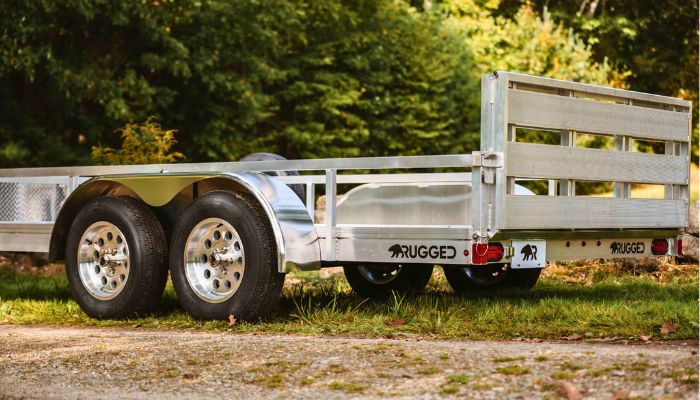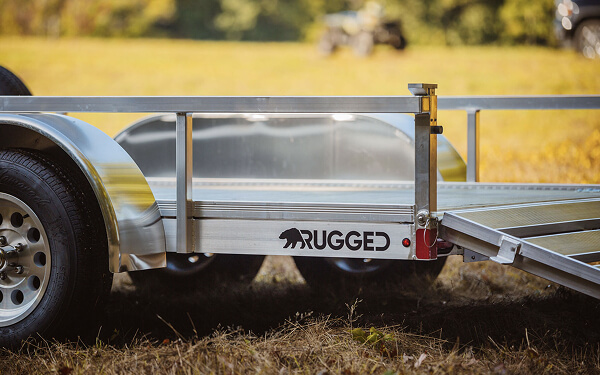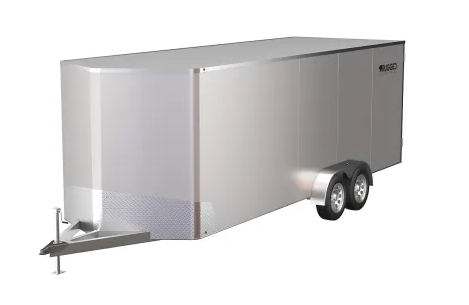The Complete Guide to Trailer Bearings: How Often to Grease and Replace Them
Quick answer: If your trailer uses standard grease or E-Z Lube® hubs, service wheel bearings every 12 months or 12,000 miles, whichever comes first. Use NLGI No. 2 lithium-complex wheel-bearing grease and avoid mixing grease types.
Rugged Aluminum Trailers ride on Dexter Torflex® rubber torsion axles for a smoother, quieter haul with less road shock to the wheel ends. The suspension itself needs very little attention beyond checking fasteners. The hubs, bearings, seals, brakes, wheels, and tires still follow a normal maintenance schedule.
If you’re just getting into trailer ownership, check out our [How Much Does a Trailer Cost in 2025] guide for a breakdown of what affects pricing and long-term value.
What trailer bearings do and why they matter
Bearings let your wheels spin freely under load while controlling heat and friction. When grease breaks down or contaminants get in, friction increases, hubs overheat, parts wear, and failures stack up. A simple annual service prevents most of that.
Problems that start with neglected bearings:
- Overheating and discoloration
- Seal failure and grease loss
- Scored spindles and ruined hubs
- Wheel vibration or, in extreme cases, separation
The three bearing setups you’ll see on Rugged builds
1) Standard grease bearings (tapered rollers)
Traditional inner and outer bearings repacked by hand on a set schedule.
2) E-Z Lube®
Grease flows through the spindle, across the inner bearing, and back out through the cap. It makes top-offs faster and cleaner. You still keep the same annual or 12k interval and perform periodic inspections.
3) Nev-R-Lube® (sealed cartridge)
Factory-sealed bearing cartridge. No periodic greasing or adjustment. Inspect yearly. Not intended for water immersion.
Fit note for Rugged:
- #10 Torflex® on our utility trailers typically uses standard grease or E-Z Lube® hubs.
- #11 Torflex® on our deck-overs can be configured with E-Z Lube® or 42 mm Nev-R-Lube® cartridges up to 6,000 lb.
If you’re unsure which hub style you have, check your build sheet or call us with your VIN.
How often should you grease trailer bearings
- Standard grease or E-Z Lube®: every 12 months or 12,000 miles. If you tow in salt, dust, mud, or water, inspect more often.
- After immersion: Non-E-Z Lube® hubs should be repacked after each immersion. If a hub was removed for any reason, install new seals before using the E-Z Lube® fitting.
- Nev-R-Lube®: no greasing. Inspect yearly for noise, roughness, heat, or end-play.
Grease spec: NLGI No. 2 lithium-complex, high-temperature wheel-bearing grease with EP, corrosion, and oxidation inhibitors. If you switch brands or chemistries, clean out all old grease first.
Want to keep your trailer looking and performing its best? Read our [How to Clean an Aluminum Trailer the Right Way] for easy maintenance tips that help protect your investment.
E-Z Lube® top-off: the safe way
- Remove the rubber plug from the grease cap.
- Attach a manual grease gun to the zerk at the end of the spindle.
- Rotate the hub and pump slowly so grease distributes evenly.
- Stop when clean grease appears at the cap, wipe excess, reinstall the plug.
- Road test and recheck.
Important: Do not use a pneumatic grease gun. High pressure can push grease past the seal and contaminate the brakes.
Repacking standard bearings: quick outline
- Safely lift and support the trailer under the frame.
- Remove wheel and hub. Pull the outer bearing, then the inner bearing and seal.
- Clean bearings and cups completely. Do not spin bearings with compressed air.
- Inspect for pitting, spalling, corrosion, or heat discoloration. Replace cones and cups as a matched set if any damage is found.
- Hand-pack grease into each bearing until fully filled. Lightly coat the cups.
- Install a new seal.
- Set bearing adjustment: tighten the spindle nut to about 50 ft-lb while rotating the hub to seat the bearings, then back off to remove torque and finger-tighten to the first alignment for the cotter pin or nut retainer. The hub should spin freely with slight end play.
- Torque wheel nuts to the spec for your wheel and studs and recheck after a short drive.
When to replace bearings or seals
Replace bearings if you see:
- Grinding or humming, hot hubs, or metal flakes in grease
- Pitting, spalling, bluing, or a damaged cage
- Excessive end-play that does not resolve with correct adjustment
Replace seals if you see nicks, tears, or leaks. Always install new seals when the hub is off the spindle.
Nev-R-Lube® owners: what to know
- Inspect yearly. A small amount of seal weeping can be normal.
- Replace if you notice noise, roughness, excessive heat, or too much axial end-play.
- Wheel selection matters. Use the correct offset for the cartridge size.
- Cartridge replacement uses a press and a self-locking spindle nut. Follow the torque spec in your axle documentation and do not “adjust” beyond that.
Why we specify Torflex® — and how it helps wheel ends
Torflex® is a self-contained torsion suspension. Rubber cords surrounding a solid, heat-treated inner bar provide independent wheel movement and natural self-damping. That means:
- Less vibration transmitted to the cargo and the hub
- No metal-to-metal contact inside the suspension
- Fewer suspension parts to maintain
- A clean installation that can double as a crossmember in many builds
You still inspect mounting fasteners periodically. Hubs, bearings, and seals follow the normal service schedule.
For Rugged buyers: #10 vs #11 Torflex® in plain terms
- #10 Torflex® (utility): Standard grease or E-Z Lube® hubs are common. Plan on annual repacks or E-Z Lube® top-offs.
- #11 Torflex® (deck-over): E-Z Lube® is common. Select models can run 42 mm Nev-R-Lube® cartridges up to 6,000 lb, which changes your routine from “repack” to “inspect.”
If you’re unsure what size trailer is right for you, visit our [What Size Trailer Do I Need for My Vehicle and Load] article to find the perfect match.
Seasonal tips for the Northeast
- Winter salt and brine accelerate corrosion. Shorten your inspection interval if you tow through winter.
- After long storage, spin each wheel by hand and check for play before the first haul.
- Keep a spare seal kit and cotter pins in your toolbox.
For more seasonal prep advice, check out [How Much Do Utility Trailers Weigh] to understand how your load impacts bearing stress and towing balance.
Quick comparison
| Bearing type | Service interval | Ease of service | Best for |
|---|---|---|---|
| Standard grease | 12 months or 12,000 miles | Moderate | General utility and car haulers |
| E-Z Lube® | 12 months or 12,000 miles, quick top-off in between | Easy | Frequent use, seasonal towing |
| Nev-R-Lube® | Inspect yearly, no greasing | Very easy | Long-haul or enclosed trailers where low maintenance is a priority |
FAQ
How often should I grease trailer bearings
Every 12 months or 12,000 miles for standard grease or E-Z Lube®. Inspect Nev-R-Lube® yearly.
What grease should I use
NLGI No. 2 lithium-complex wheel-bearing grease with EP, corrosion, and oxidation inhibitors. Do not mix grease types.
Can I use a pneumatic grease gun on E-Z Lube®
No. Use a manual grease gun and rotate the hub while pumping to protect the seals.
Are Nev-R-Lube® bearings good for boat trailers
No. They are not designed for immersion.
What end-play is normal on Nev-R-Lube®
A small amount of axial end-play is built in. If you feel excessive movement, inspect and measure per the axle documentation.
Looking for a low-maintenance aluminum trailer with proven Dexter running gear and a smoother, quieter ride?
Build a Rugged and we’ll spec the right hub and axle option for how you tow
Related reading:
- [How Much Does a Trailer Cost in 2025]
- [How to Clean an Aluminum Trailer the Right Way]
- [What Size Trailer Do I Need for My Vehicle and Load]
R


